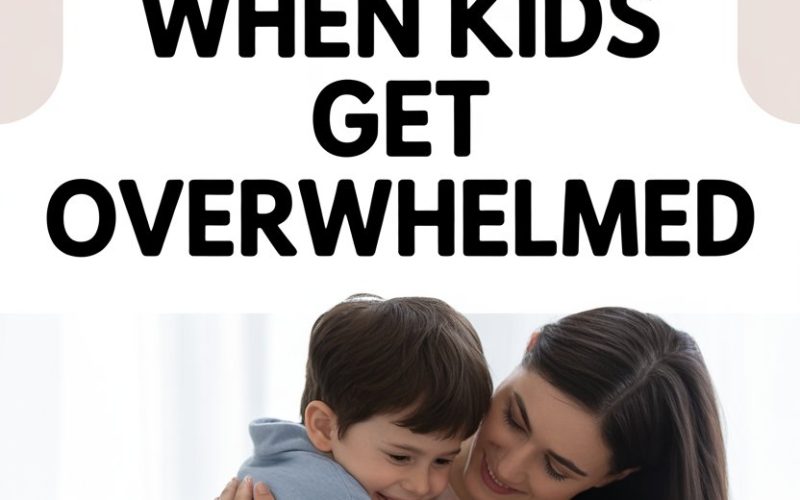Ever witnessed a child morph from giggly gremlin to a puddle of tears over maths, lost shoes, or simply because the toast “looks weird”?
Welcome to the glorious, sticky, loud world of overwhelmed kids.
It’s a rite of passage for every parent, right up there with nits and the first time someone uses your expensive face cream as finger paint.
Overwhelm isn’t just part of growing up—it’s a regular guest in the family home. The trick isn’t banishing it (good luck), but knowing how to ride it out without losing your mind or your sense of humour.
Here’s how to respond when those big feelings come knocking.
Recognise the Red Flags (Before You’re Hit by the Storm)
Picture this: Your six-year-old is suddenly hurling Lego across the lounge, or your teen slams their door so hard it echoes in the neighbour’s flat.
Overwhelm rarely arrives unannounced. It starts with small tells—snappiness, silence, clinginess, or that wild look in their eyes as if they just remembered they have double maths tomorrow.
Tuning into these early warning signals is half the battle. Catching the signs can help you step in with empathy instead of exasperation.
The Child Mind Institute notes that labeling emotions helps children feel understood, calming their brain’s alarm bells.
Pause Your Own Reaction
Easier said than done when your child’s tantrum rivals the noise of a jumbo jet. Still, your response sets the tone. Kids catch our stress like it’s a cold.
Take a beat—count to five, channel your inner Zen master, do interpretive breathing, whatever works. The goal? Respond, don’t react.
Even muttering, “This is not about me,” under your breath can help. The National Parenting Initiative’s research shows that kids mirror the emotional temperature set by their adults.
Name the Feeling Without Judgement
Once the volcano erupts, skip the “Don’t be silly, it’s just a sock!” and try naming what you see. “Looks like you’re really frustrated about your sock.” Magic? No. Effective? Actually, yes.
When children hear their feelings echoed back, it tells them their emotions aren’t too big for you.
Psychologists call this emotion coaching, and it builds emotional literacy. Over time, kids become better at handling their own feelings—less shriek, more speak.
Shrink the Problem Together
Overwhelm turns tiny issues into giants with bad breath. You don’t need a cape or a wand.
Just help your child break the big scary thing into baby steps. Is it a pile of schoolwork? Start with one sheet. Packing for camp? Tackle clothes, then toiletries.
This technique, often called chunking, makes the mountain feel climbable. “Let’s just do this bit, then have a biscuit break” never hurt anyone.
Offer Choices—Even Tiny Ones
Overwhelmed kids feel powerless, like passengers on a runaway train. Offer them small choices to put them back in the driver’s seat.
“Do you want to brush your teeth before or after you put on pyjamas?” “Would you like the blue cup or the yellow one?”
Choice gives a sense of control, which dials down anxiety. There’s research to back this up: Parents helps build confidence and resilience.
Bring Out the Calm-Down Toolkit
You need more than a wet flannel. The toolkit can include deep breaths, counting backwards, squeezing a stress ball, running round the garden, or hiding under a makeshift duvet fort.
Bonus points for anything with a whiff of silliness.
Not all strategies work for every child—some may need music, a cuddle, or a little space to stomp it out. Experiment, and don’t be afraid to let them lead the way.
The Child Mind Institute has a fantastic cheat sheet of calming techniques.
Stay Close, Even If They Don’t Want to Talk
Some children are verbal tornadoes when overwhelmed; others go into full tortoise mode. You don’t have to force a “heart-to-heart.”
Just being nearby—folding socks, chopping veg, or patting the cat—lets them know you’re available.
Attachment theory shows that presence matters. Sometimes that’s all it takes for a child to surface, ready to talk or just ready to accept a biscuit.
Normalise Big Feelings (Even the Messy Ones)
The world loves “good vibes only.” Real life? Not so much. Everyone feels swamped sometimes.
Share your own (child-friendly) stories of getting overwhelmed and what got you through. “I wanted to hide in the loo when I lost my car keys before work!”
Normalizing ups and downs removes the shame. Kids see that grownups wobble too, and that’s okay.
Problem-Solve Once the Waters Calm
The middle of a meltdown is the wrong time for pep talks or troubleshooting.
Wait for the emotional storm to pass, then chat about what might help next time. Maybe it’s putting out the school uniform the night before, or making a “worry box.”
A study from Harvard’s Center on the Developing Child found that involving children in finding solutions boosts resilience and self-esteem.
Know When to Seek Extra Help
If your child’s overwhelm is constant, intense, or starts to affect daily life—think eating, sleeping, school, or friendships—it’s time to chat with your GP, a school counsellor, or a child psychologist.
No shame, no drama. Getting support is a sign of strength, not a parenting fail.
Early support works wonders. You’re never alone in this.
A Note on Your Own Overwhelm
Parenting is a team sport, and your batteries need charging too. No one can pour from an empty cup (or keep refereeing sibling squabbles on two hours’ sleep).
Reach out to mates, steal a quiet cuppa, or get some fresh air. If overwhelm becomes your daily companion, consider seeking support for yourself as well—there’s no medal for “parent who never takes a break.”
Overwhelm Happens—You’ve Got This
Kids will always have moments when the world feels “too much.” That’s not a parenting failure; it’s a sign you’re raising a human, not a robot.
With a little empathy, a dash of patience, and the odd deep breath (or chocolate square), you can help your child weather even the wildest emotional storms.
And if all else fails, there’s always the classic: “Shall we both hide under the covers until teatime?”





